- Introduction
- History
- Climate
- Soil and Site Selection
- Propagation
- Orchard Establishment
- Irrigation
- Fertilization
- Pruning and Training
- Pollination
- Pathogens
- Pests
- Harvest Maturity
- Postharvest Handling and Storage
- Peeling a Pomegranate
- Juicing a Pomegranate
- Sources
Pomegranates have been grown as a common backyard crop for decades in the South. In recent years, there has been an increased interest in the commercial production of the fruit in Georgia and surrounding regions. This production increase is largely in response to increased demand for the fruit by the consumer. Global production has increased substantially in the past decade, and pomegranate is being consumed not only as a fresh fruit, but also as juice or as a freshly prepared product. The fruit is also being utilized in numerous consumer products, including tea and juice blends, nut mixes and countless other food and non-food stuffs.
This publication describes current knowledge specific for the commercial and backyard growing of pomegranate in Georgia, as well as general production practices common in other pomegranate-producing regions. However, it should be noted that limited local knowledge is available, and the information contained in this publication is based largely on the fruit produced at the UGA Ponder Farm, an orchard that was planted in 1991-1994.
Introduction
The pomegranate (Punica granatum) is a naturally dense, deciduous, bushy, multi-stemmed shrub that typically grows to heights of 10 to 12 feet and bears highly colored fruit with many juicy seeds inside. In some regions, pomegranates are trained into small trees with a single trunk. The branches tend to be slender and thorny, while the leaves are glossy and dark green. The colorful orange-red flowers appear in the spring and summer and are either bell-shaped (female) or vase-shaped (hermaphroditic), with the latter type being sterile. The edible portion of the fruit, called an aril, is comprised of hundreds of seeds surrounded by juicy pigments, each contained within a seed coat (Figure 1). Seeds are either soft or hard, depending on the cultivar. The juice within the aril varies from light pink to dark red, but can also appear yellow or clear in some varieties. The juice ranges from very acidic to very sweet in taste. The rind is generally smooth but leathery, and can be yellow, orange or red in color.
 Figure 1. Arils of pomegranate cultivar 'Kaj-acik-anor'. Arils are comprised of the outer shell, seed and, as seen in this cultivar, a brightly pigmented red juice.
Figure 1. Arils of pomegranate cultivar 'Kaj-acik-anor'. Arils are comprised of the outer shell, seed and, as seen in this cultivar, a brightly pigmented red juice.
History
In old Latin, the name Malum punicum literally translates to "Apple of Grain" or multi-grain, in reference to the multiple seeds in the fruit. However, the current Latin name Punica granatum L. is derived from "Pomuni granatum," a name traced back to the middle ages, which translates to "seeded apple." Domestication of the pomegranate is believed to have begun in Central Asia and Persia nearly 4,000 years ago, and then spread east and west through hot, arid regions of India, Asia Minor and the Mediterranean coast. Spanish settlers first introduced the fruit to North America, including missions on the Georgia coast, in the 16th century. Pomegranate has been a reasonably common backyard or dooryard plant in south Georgia for centuries. The plants are long-lived and bear fruit for decades. The origin of the Georgia plants is largely unknown; however, research efforts are being made to locate, identify and characterize these local trees.
There is some debate as to the origin of the 'Wonderful' cultivar. One version of the story suggests that in 1896, the 'Wonderful' cultivar was discovered in Florida and brought to California (where it was subsequently commercialized) by a Mr. Birs. Another version suggests that a shipment of cuttings and/or seedlings was shipped to Porterfield, Calif., where the 'Wonderful' cultivar was discovered amongst the plants. Although it has become the major cultivar in California, it performs very poorly in Georgia.
Climate
Most pomegranate cultivars are hardy down to 12 degrees F, with the hardier types surviving without damage down to 7 degrees F. Anecdotal evidence suggests that hard-seeded varieties are more cold-hardy than the soft-seeded types. The majority of pomegranate varieties do not require winter chill hours, with the exception of a few cold-hardy cultivars. Consequently, wood is always susceptible to injury. All varieties will benefit from a rest period or "dormancy," though assigning a minimum chill hour requirement is not currently possible.
The tree is most resistant to the cold in the winter months, and tends to be more susceptible to frost damage prior to reaching full "dormancy" in the fall and at bud break in the spring. It is during these periods that the bark is most susceptible to damage from frost, which usually occurs first on the south side of the tree closest to the ground. If frost damage is a problem, a possible solution is to paint the bark white with flat latex paint in order to reduce fluctuations between day and nighttime temperature extremes.
Pomegranates are extremely heat tolerant, and perform best when temperatures are above 85 degrees F for at least 120 days a year. The trees are also drought-tolerant; however, supplemental irrigation is necessary during tree establishment and is critical for commercial fruit production. Without irrigation during prolonged periods of drought, fruit production will be lost, and substantial injury to young trees is likely.
Soil and Site Selection
Pomegranates perform best on deep loamy soils, but will still grow quite well in sandy and clay soils. Trees are tolerant of moderately acid to slightly alkaline soils and grow best in a soil pH range of 5.5 to 7.2. Though pomegranates can tolerate short periods of standing water, they prefer well-drained soils. Extended periods of excessive moisture will harm the trees. Pomegranates are also moderately tolerant to salts and can withstand irrigation with water containing 2,000 to 2,500 ppm salt.
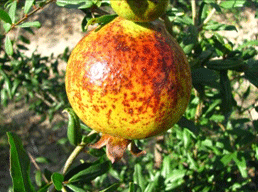
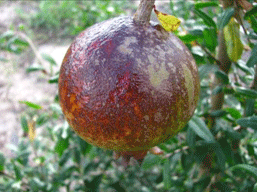 Figure 2. Example of sunscald (top) and sunburn (bottom).
Figure 2. Example of sunscald (top) and sunburn (bottom).Aside from soil type and drainage, site selection should also take into consideration sun exposure and air circulation. Pomegranates require at least six hours of direct sunlight a day in order to ensure good fruit color and productivity. Aligning the orchard rows north-south will maximize sun exposure. However, soil drainage is more important than row orientation. In most of south Georgia, pomegranates should be planted on a raised bed at least 4 feet wide and 6 to12 inches in height. A water furrow can be added to each aisle if additional drainage is needed.
Though pomegranates are susceptible to sun scald, only a small percentage of fruit will normally be damaged in a given season. Sunscald appears as a change in blush of the fruit, and will appear on the sun-exposed side of the fruit. Sunburn is a progression of sunscald, and appears as either severely darkened skin or as dry, necrotic and cracked skin in severe cases. Kaolin can be used to reduce sunscald, which, if left unmanaged, may lead to sunburn. If the fruit will be marketed fresh, the kaolin spray must be washed off after harvest since it appears as pesticide residue. High incidence of sunburn can contribute to weakened rind and subsequent cracking (Figure 2).
Air circulation is important, especially in the spring during bloom. Flowers may not set or will abort if conditions are too humid. Thus, open areas free from shade with a gentle slope to promote natural air drainage are encouraged.
Pomegranates in other production regions are reportedly susceptible to root-knot nematode. As a precaution, new orchards in Georgia should not be established in areas with known root-knot nematode infestations.
Propagation
Pomegranates can be propagated from softwood or hardwood cuttings. Hardwood cuttings are the preferred means of propagation, but softwood cuttings collected in early fall can be used with varying degrees of success. A tree from a hardwood cutting will bear fruit in year two after planting, while it will take at least three years from seed. Trees will reach maturity in five to seven years, and can live up to 200 years.
For hardwood cuttings, remove approximately 10 inches of one-year wood in late fall or early winter. Cuttings should be approximately ¼ to ½ inch in diameter, or about the same width as a pencil. Suckers from the base of the plant or from the interior of the canopy often make some of the best wood for cuttings. Cuttings can be propagated either in a pot containing a modified soil or soilless media or directly in ground, spaced about a foot apart in a nursery row. Stick the cuttings, leaving only 2 to 3 inches of the top of the cutting exposed. It is preferable to have at least three nodes under the surface. Rooting hormones, mist bed and root zone heating (75 degrees F) will increase the success rate but are not required. Allow the cuttings to grow for the season. The following spring, transplant the cuttings bare root into the orchard at proper spacing.
One suggested protocol for propagating pomegranates is as follows:
- Stick in February, after "dormancy" period is complete, in 1:1 vermiculite:perlite.
- After 1 inch of root growth, transplant into a tall pot with 1:1:1 peat:bark:perlite.
- After establishment, transfer to tall 1-gallon pots in soil, and support with bamboo.
Orchard Establishment
Rooted hardwood cuttings are planted bare root in late winter or early spring. Pomegranates can be placed directly in-ground or on raised beds. The latter is recommended, especially if a high water table or poor drainage is suspected. An herbicide, such as Surflan A.S., should be used prior to transplanting to remove competition from other plant species. Pre-emergent herbicides such as Goal can be applied during dormancy. Applications of Touchdown HiTech (glyphosate) in row middles are performed throughout the season. Basagran is also a registered herbicide for nonbearing trees, and can be used in rotation with other labeled herbicides. Consult label for rates and application restrictions, and refer to the current edition of the Georgia Pest Management Handbook for the most current information.
Mulch can be used in a manner similar to blueberry production to prevent weed invasion and to preserve soil moisture content around the young plant.
Optimal tree spacing has yet to be determined for production in the Southeast. Traditional spacing for an orchard is 18' x 18' (134 trees/acre). This density permits adequate sunlight penetration for fruit color, adequate airflow between trees and efficient movement of people during harvest. Tighter densities, such as 16' x 18' and 14' x 18', have been used with some degree of success in regions other than Georgia. However, these densities, especially the latter, should be approached with caution as they will require diligent pruning and canopy architecture training in order to not have an adverse effect on yield once the orchard reaches maturity. Some local growers are attempting tighter densities of 10' x 15' (290 trees/acre). Since it will not be known if this density is manageable until the orchard matures, this is not a currently recommended strategy.
The first harvest is in year three, but these fruit will tend to be small and late-maturing. The focus should be on tree growth as opposed to fruit production in these early years, and it is not uncommon for the majority of fruit to drop prematurely. Full commercial production begins occurring in years five or six.
Irrigation
Though pomegranates are very drought tolerant, ensuring adequate soil moisture will result in a substantial improvement in plant vigor and fruit yield. Furthermore, providing adequate water throughout drought periods will help minimize the amount of fruit splitting when the rain returns. Drip irrigation is the preferred method. Overhead irrigation is not advisable as it will increase the spread of field pathogens and may also result in reduced fruit set because the flowers are highly sensitive to humidity and moisture. Excessive soil moisture in the summer can lead to an abundance of vegetative growth, but the fruit produced will tend to be softer, resulting in poor postharvest quality. Avoid excessive irrigation in the fall as it may contribute to fruit splitting. This splitting can lead to increased rates of infection from field-borne diseases, which will eventually develop during storage.
Fertilization
Soil pH should be adjusted to 6.5 with dolomitic limestone before planting. Phosphorus should also be incorporated in the soil by adding 150 pounds per acre of triple superphosphate if the phosphorus level is less than 20 pounds per acre.
If you are planting small plants, a small amount of non-burning, controlled-release nursery fertilizer is recommended to help with establishment. If you are planting a 1 gallon-size plant, a suggested rate of fertilization is 1 ounce of 10-10-10 per foot of bush height three times a year (early spring, late spring and summer) applied evenly in a circle about 18 inches in diameter with the plant in the center. Continue to increase the diameter of the circle and the rate as the plants grow, up to a maximum of 8 ounces per application when the plants are 8 feet tall. Under conditions of heavy rainfall or very sandy soil, additional fertilizer should be applied. Nitrogen rates in California can be up to 100 pounds per acre per year on mature trees. Phosphorus and potassium should be applied based on soil and leaf analysis.
It is very important to note that excessive nitrogen in the late summer to early fall will have a detrimental impact on fruit color and size, and may also increase the susceptibility of the tree to early chilling temperatures. As for other macronutrients, phosphorus and potassium need only be applied if soil tests or leaf analysis indicate a deficiency. One of the few common deficiencies found in pomegranate is zinc, which appears as unusual yellowing of the leaves. If required, a foliar zinc application in the spring after fruit set is recommended.
Pruning and Training
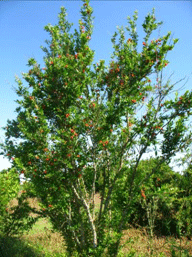
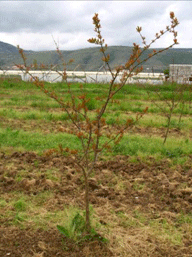
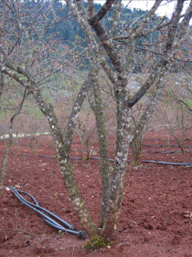 Figure 3. Examples of multi-trunk (top), single-trunk (center) and triple-trunk (bottom) tree training strategies.
Figure 3. Examples of multi-trunk (top), single-trunk (center) and triple-trunk (bottom) tree training strategies.There are two common approaches for training a pomegranate plant: single or multi-trunked. The multi-trunked form is probably best in Georgia. The single-trunk plant has a short (12-18") trunk with five to six major branches diverging to form a vase-shaped structure. The multi-trunk plant has three to six of the strong branches developed directly from the ground.
The single-trunk approach has the advantages of easier orchard floor maintenance and reduced costs associated with pruning suckers. Though this approach is popular in California, it has not been readily adopted by other pomegranate-producing regions of the world.
One major advantage of the multi-trunk approach is that if a freeze event occurs and damages a portion of branches, you can simply remove them and train a vigorous sucker to take their place without a significant loss in production. In the single-trunk system, you would have to replace the entire tree.
The single-trunk system requires more labor while establishing the canopy architecture and placing supporting wires, but requires less labor after the orchard is established relative to the perpetual removal of suckers required in the multi-trunk system. However, the multi-trunk system will not require as many supporting wires.
For single-trunk production, remove all but the strongest sucker and select branches off this sucker. For a multi-trunk system, select five or six vigorous suckers and allow them to grow, or, as a compromise between the two approaches, use a triple-trunk system (Figure 3).
Pomegranates require pruning each year, and unneeded growth and suckers should be removed regularly. Short fruiting spurs appear primarily on two- or three-year-old wood, and are found growing mostly on the outer perimeter of the canopy. Light annual pruning encourages growth of new fruit spurs, while more aggressive pruning will significantly impact yield. Therefore, pruning must be performed on an annual or semi-annual basis in order to minimize the onerous task of aggressive pruning, and to reduce the likelihood of removing excessive amounts of fruit-bearing (older) wood.
Major pruning should take place during the winter months prior to bud break, with minor pruning for sucker removal in mid-summer. Major pruning is where the tree architecture is established. Efforts should be made to maintain an open, vase-shaped tree with enough lateral branches to support the tree (including the weight of the fruit) without excessively inhibiting airflow, sunlight penetration or excessive fruit rub on windy days.
The weight of the fruit on a branch can be substantial. Support these branches to ensure that fruit does not come into contact with the orchard floor, remains clear of farm equipment and is away from ground-level critters. Injury from wind, called limb rub or wind scars, are wounds that can have a major impact on quality for fruit intended for the fresh market, and can lead to entry points for pathogens. Trees can be maintained at a height that minimizes ladder work by the harvest crews (approximately 9 feet), though trees will naturally grow to 10-12 feet. After year five, ground suckers may be controlled with careful use of herbicides.
Pollination
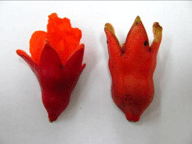
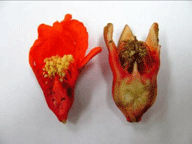 Figure 4. The exterior (top) and interior (bottom), of the vase-shaped male (left flower) and peanut-shaped hermaphroditic (right flower) pomegranate.
Figure 4. The exterior (top) and interior (bottom), of the vase-shaped male (left flower) and peanut-shaped hermaphroditic (right flower) pomegranate.Pomegranates are self-fruitful. The primary pollination vectors are insects and hummingbirds. Bloom begins in April and continues through to June, either in a continuous manner or in three to four flushes (variety dependent). It is not unusual for pomegranate to produce flowers well into fall; however, the majority of the blooms appear early in the spring and will result in the largest fruit at maturity.
There are two types of blooms: hermaphroditic and functionally male. The hermaphroditic fruit-bearing flowers can be identified by their fuller, more rounded base, which appears somewhat peanut or bell-shaped. The male non-fruit-bearing flowers will be more narrow and vase-shaped (Figure 4).
Pathogens
There is limited information about the disease pressures specific to pomegranates produced in Georgia. The information that is available so far has been obtained from harvested fruit, and no information is currently available about the economically important pathogens that may be present on pomegranate leaves and in the orchard environment. In general, the fruit and trees are considered reasonably disease-tolerant. Currently, there are no registered products for the control of diseases.
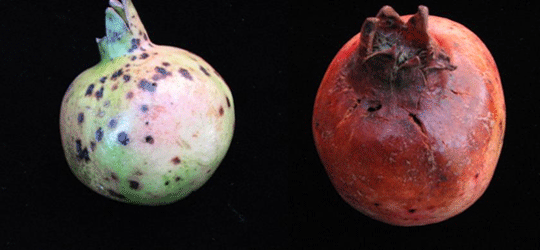 Figure 5. Example of Cercospora punicae (left) and Botryosphaeria spp (right). Photographs courtesy of Dr. Harald Scherm and Lucky Mehra, UGA Department of Plant Pathology.
Figure 5. Example of Cercospora punicae (left) and Botryosphaeria spp (right). Photographs courtesy of Dr. Harald Scherm and Lucky Mehra, UGA Department of Plant Pathology.With respect to the known pathogens from Georgia, fruit harvested from the Ponder Farm Pomegranate Orchard displayed symptoms caused by the infection of Cercospora punicae and Botryosphaeria spp. (Figure 5). Other organisms that were also present on the fruit (but did not cause any symptoms) included: Aspergillus, Cladosporium, Colletotrichum, Epicoccum, Penicillium, Pestalotia and Phomopsis spp. Further surveys and studies on the pomegranate diseases in Georgia are needed. Pomegranate growers are encouraged to report their experiences to their local county agent or Extension offices.
One of the most interesting findings was that Alternaria spp. was not present. This is a major problem in some other production areas (California). Alternaria spp. usually enters the fruit during bloom/fruit set. As the fruit develops, the fungus spreads through the interior of the fruit, while leaving the exterior untouched. This type of disease is often called "black heart" or "heart rot," and there is no known method of control. There is some evidence suggesting that occurrence is greater when moisture is present during bloom. Even though Alternaria spp. was not present at the Ponder Farm orchard that does not mean that it is not present in other production regions in the state.
Other U.S. production areas, including Florida, have found an unidentified fungal disease that can affect both fruit and leaf tissues. The leaf symptoms include small spots or angular regions that are dark red-brown in color and about ¼-inch in diameter. Fruit symptoms appear as dark brown spots. Presence of the disease causes premature leaf and fruit drop. The described disease may be Cercospora punicae, or may be some other unknown disease. It was treated with a copper fungicide in late spring and early summer with reasonable success.
Pests
There is no information about the pest pressures specific to pomegranates produced in Georgia. The only products available for pest management of pomegranate include: Lannate, Admire and Dipel. There are opportunities for using chemicals that are considered reduced-risk or that carry tolerance-exempt status. These products can be used on any crop, and include: B.t. sprays, soaps, sulphur dusting, plant oils and omnivorous leafroller pheromone mating disruption.
So far, there have been few insect pest problems on Georgia pomegranate farms. However, other U.S. production areas have problems with the following pests: Flat mite (Brevipalpus lewisi), omnivorous leafroller (Platynola stultana), root-knot nematode, mealybug, melon aphid, thrips, whitefly, scale (citricola, black and California red) and katydid. However, very few of these have caused any significant damage, and seldom required control. If mites become an issue, a sulphur dusting in June followed by a second application in July (if necessary) can offer some protection. White aphids in these other production regions are routinely controlled using soap, but can also be controlled with an application of Lannate. The use of dormant oil sprays (3 percent) in winter has been effective against scale. However, more research is required to first identify and then determine an appropriate recommendation for the control of Georgia pomegranate pests.
Harvest Maturity
Pomegranates in general do not have a synchronized single spring bloom and can have shoot flushes that bear flowers throughout the warmer parts of the year. Early cultivars will begin to ripen near the end of August, and will continue through to October or early November for the late-maturing cultivars. Except for intensive production where once-over harvesting is occasionally practiced, plan on harvesting two to four times per season.
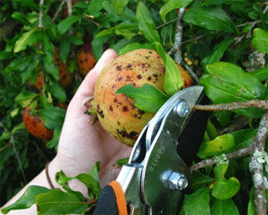
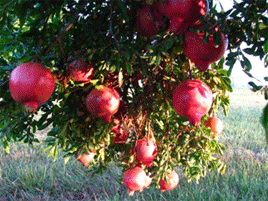 Figure 6. (Top) Use clipping shears and cut as close to the fruit base as possible. (Bottom) 'Nikitski ranni' near harvest at Ponder Farm, Tifton, Ga.
Figure 6. (Top) Use clipping shears and cut as close to the fruit base as possible. (Bottom) 'Nikitski ranni' near harvest at Ponder Farm, Tifton, Ga.Harvest maturity is determined by sugar and acid contents, sugar:acid ratio and the color development of the fruit. With experience, proper harvest maturity can also be determined by tapping the fruit and listening for a metallic "ting" sound. In general, for 'Wonderful,' the acids should be lower than 1.85 percent, soluble sugar content greater than 16 to 17 percent and the sugar:acid ratio greater than 18.5. A Munsell color chart has been used for determining the color score of the fruit rind. However, rind color values will vary with season and should only be used in combination with other maturity tests. Harvest maturity indices for cultivars other than 'Wonderful' are not currently available, but it is known that they will differ significantly from the benchmark values established for this cultivar.
Compared to other similar crops, pomegranates are easy to harvest and require minimal ladder work (assuming proper pruning and training of the tree). Fruit are harvested by clipping them with shears (Figure 6). Cut as close to the fruit as possible to prevent a sharp point of wood from piercing and rubbing against other fruit in the bin. Fruit are placed either directly into bins located in the orchard, or into shoulder harness baskets (identical to those used in the apple industry) while working around the tree. Either way, fruit should be handled with care in order to minimize scuffing or cracking (a strong bump may cause the fruit to split open).
Postharvest Handling and Storage
Postharvest handling of pomegranate is similar to that of apple. After harvest, fruit are transported to a sorting facility in a timely manner. It is not necessary to pre-cool fruit after harvest, but fruit will benefit from being placed into cold storage as soon as possible after harvest. Fruit destined for the fresh market should be washed with chlorine, rinsed with water and sorted by culls, cracks, defects, color, size and weight. Fruit should also be treated with a postharvest fungicide such as Scholar (Syngenta), especially if they will be placed into longer-term cold storage. A storage wax can also be applied to promote the visual quality of the fruit and increase its storage life by reducing moisture loss. Fruit destined for the fresh market can either be placed in storage bins (for later packaging) or packaged immediately into appropriate cartons for the desired market (e.g., cardboard bin for 28, 25, 22 or 5 pounds). Pomegranates are sorted into two grades, 1 or 2.
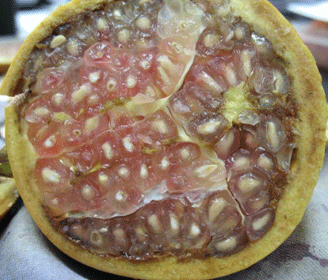 Figure 7. Chilling injury in 'Don Sumner South Tree' after eight weeks of storage in air at 5 degrees C (41 degrees F).
Figure 7. Chilling injury in 'Don Sumner South Tree' after eight weeks of storage in air at 5 degrees C (41 degrees F).Fruit can be stored up to six weeks in open-air storage or five months using controlled atmosphere storage (CA). CA is also useful for controlling the incidence of storage scald (the browning of the red pigments in the rind of the fruit). For high quality fruit, the lowest temperature used should be 41 degrees F for short-term storage (less than three weeks); 45 degrees F is more appropriate for longer-term storage. For fruit with known disease pressures, it is advisable to store for less than three weeks at a reduced temperature of 32-34 degrees F. Low temperature discourages pathogen growth and spread, but will also cause chilling injury in fruit stored longer than three weeks. This will ultimately result in increased pathogenicity during and after removal from low temperature storage.
Chilling injury is a time by temperature interaction. A relatively short period at a low temperature may not cause damage, but an extended period at that same temperature will. It is important to select a temperature appropriate for the anticipated storage period. Chilling injury appears as the browning of the white interlocular membrane and arils. Arils will lose their desirable pigment and will also soften, resulting in higher levels of pathogenicity (Figure 7).
Peeling a Pomegranate
Pomegranates are often cited as being difficult to peel and the juice can readily stain clothing. The following describes a technique for minimizing juice stains and increasing the ease of aril removal.
When preparing the fruit in a kitchen, first slice off the calyx of the fruit with a knife. Carefully score the exposed surface into quarters. Fill a bucket or other container with water, and then submerge the fruit. With the fruit submerged, pry open the fruit along the score lines and remove the arils with a rolling action under your thumb. The arils will sink to the bottom of the container, while all the pulp, peel and damaged seeds will float to the top. Once you have finished, remove the floating debris and pour the water through a suitable strain. With practice, a pomegranate can be peeled in minutes. Commercial scale equipment for aril removal is available from a select number of manufacturers based out of Israel and India.
Juicing a Pomegranate
Pomegranate juice has increased in popularity because of its nutritional value and taste. Juice is a more convenient way of ingesting the beneficial health compounds that are present in the fruit. However, different pomegranate cultivars will have varying levels of juice yield, color and antioxidant content. Furthermore, the optimum processing conditions that affect these quality aspects might vary depending on the cultivar.
Home juice production can be simply accomplished by separating the arils (as described above) and then pressing the arils in cheesecloth, or using an electric blender followed by straining to remove the seeds. Laboratory scale juice extraction can involve numerous steps, including: opening the fruit, separating the arils and pressing to extract the juice. Numerous other optional steps then follow to strain, filter, purify and pasteurize the juice prior to bottling. In all cases, temperature control is very important. For home juice production, juice should be consumed fresh or stored in the refrigerator for only a short period of time.
Before choosing a variety for juicing, several different quality aspects need to be considered. Some cultivars may have the desirable color and antioxidant content, but may not have the best yield. For example, 13 Georgia-grown pomegranate cultivars were evaluated for juice yield and antioxidant content. Juice yield ranged from 24 to 39 percent of fruit weight, while there was a two-fold range in antioxidants from the lowest to highest. Thus, it is desirable to conduct a small study to determine juice yield. This can be easily done with the weight of the whole fruit and the weight of the juice using the following formula:
% Juice = (Juice Weight × 100) ÷ Whole Fruit Weight
To determine other quality aspects, such as color, antioxidant content, sugar and acid content, a private laboratory may be used.
Sources
Devin Carroll, Bernard Puget, Brad Higbee, Matt Quist, Octavio Magallenes, Norman Smith, Andreaa Gjerde and Ken Schneider. 2006. Pomegranate pest management in the San Joaquin Valley.
Richard Ashton, with Barbara Baer and David Silverstein. 2006. The incredible pomegranate plant and fruit. Third Mellennium Publishing. http://www.3mpub.com/ashton/title1.html
Robert Hodgson. 1917. The pomegranate. College of Agriculture, Agricultural Experiment Station, Berkeley, California. University of California Press. Bulletin no. 276.
Julian Sauls. 1998. Home fruit production — pomegranate. Texas Citrus and Subtropical Fruits, in association with Texas A&M University. http://aggie-horticulture.tamu.edu/citrus/pomegranate.htm
James LaRue. 1977. Growing pomegranates in California. University of California DANR Leaflet 2459.
Gerard Krewer, Thomas Crocker, Paul Bertrand and Dan Horton. Minor fruit and nuts in Georgia. University of Georgia Cooperative Extension Bulletin 992.
Sheets, M.D., Du Bois, M.L., Williamson, J.G. 1994. The Pomegranate. University of Florida IFAS extension publication #HS44.
Status and Revision History
Published on Jan 26, 2011
Published with Full Review on Jan 04, 2014
Published with Full Review on Mar 28, 2017
Published with Full Review on Jun 24, 2022


























































